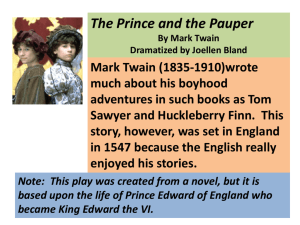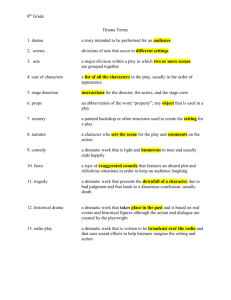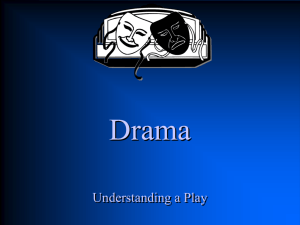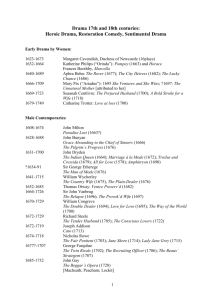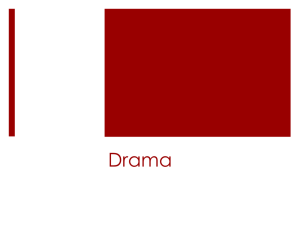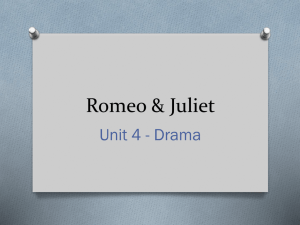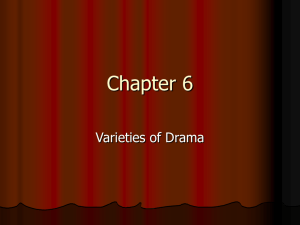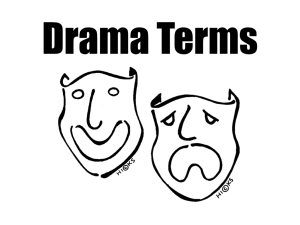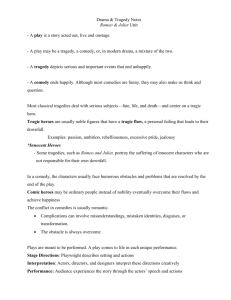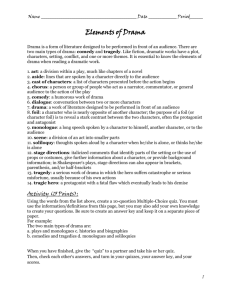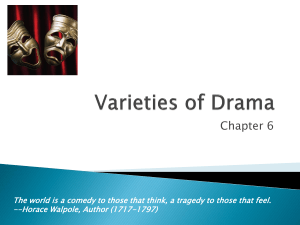June 20 English Notes
advertisement
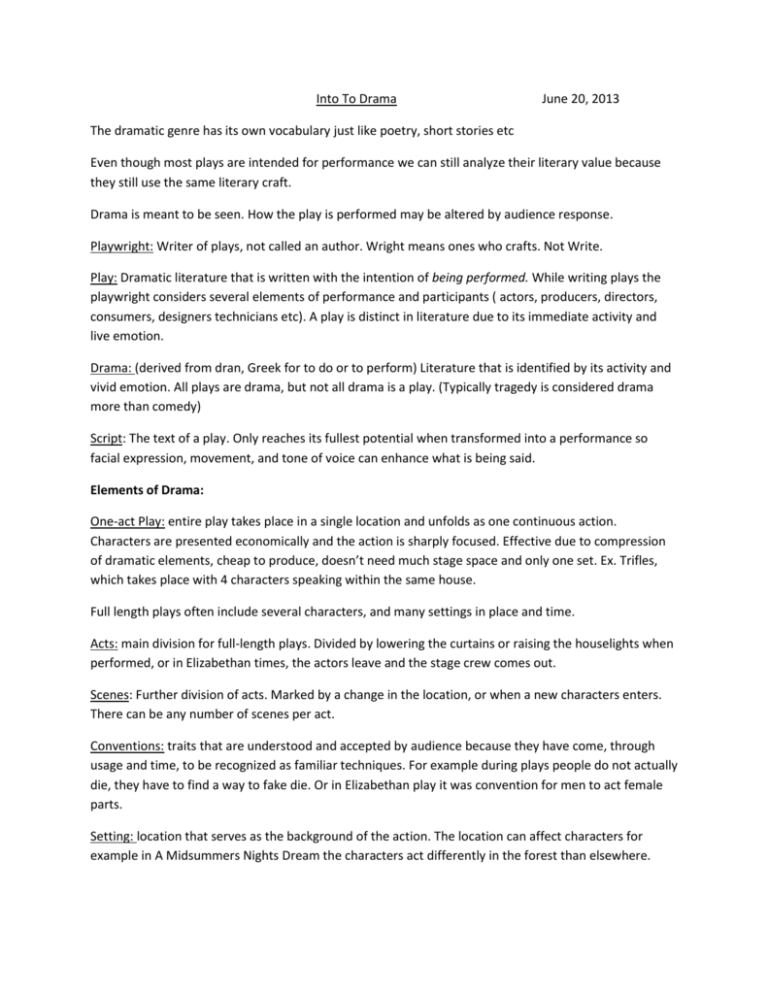
Into To Drama June 20, 2013 The dramatic genre has its own vocabulary just like poetry, short stories etc Even though most plays are intended for performance we can still analyze their literary value because they still use the same literary craft. Drama is meant to be seen. How the play is performed may be altered by audience response. Playwright: Writer of plays, not called an author. Wright means ones who crafts. Not Write. Play: Dramatic literature that is written with the intention of being performed. While writing plays the playwright considers several elements of performance and participants ( actors, producers, directors, consumers, designers technicians etc). A play is distinct in literature due to its immediate activity and live emotion. Drama: (derived from dran, Greek for to do or to perform) Literature that is identified by its activity and vivid emotion. All plays are drama, but not all drama is a play. (Typically tragedy is considered drama more than comedy) Script: The text of a play. Only reaches its fullest potential when transformed into a performance so facial expression, movement, and tone of voice can enhance what is being said. Elements of Drama: One-act Play: entire play takes place in a single location and unfolds as one continuous action. Characters are presented economically and the action is sharply focused. Effective due to compression of dramatic elements, cheap to produce, doesn’t need much stage space and only one set. Ex. Trifles, which takes place with 4 characters speaking within the same house. Full length plays often include several characters, and many settings in place and time. Acts: main division for full-length plays. Divided by lowering the curtains or raising the houselights when performed, or in Elizabethan times, the actors leave and the stage crew comes out. Scenes: Further division of acts. Marked by a change in the location, or when a new characters enters. There can be any number of scenes per act. Conventions: traits that are understood and accepted by audience because they have come, through usage and time, to be recognized as familiar techniques. For example during plays people do not actually die, they have to find a way to fake die. Or in Elizabethan play it was convention for men to act female parts. Setting: location that serves as the background of the action. The location can affect characters for example in A Midsummers Nights Dream the characters act differently in the forest than elsewhere. Exposition: device that provides the necessary background information about the characters and circumstances (often via dialogue). Used to provide information while simultaneously developing characterizations and moving the action forward. (Characters talk about the past to get readers to know the situation) Dialogue: verbal exchanges between characters. Conflict: point of contention that presents an obstacle to the protagonist Plot: the authors arrangements of incidents in the play that gives the story a particular focus and emphasis; includes what happens, how it happens, and why it happens. Subplot: (often in longer dramas) secondary action that reinforces or contrasts the main plot. It is as if there are two separate stories but they sometimes cross paths and effect each other. Ex in “Trifles” women are the main plot and the men are the subplot. Protagonist: central characters with whom we tend to identify with. Must struggle to overcome conflict. Antagonist: Thing (person, nature, or self) opposed to the central character. Ex. Mrs hale and mr Henderson (the attorney) are in opposition as each represent different value systems. Stage Directions: playwright’s instruction about how the actors are to move and behave. This is essential as the movements, positioning, and volume of the actor affects meaning. Notes from Chapter 24: Tragedy Aristotle defined tragedy in his work, poetics, using contemporary plays as the basis of his definition. Nonetheless, we continue to use his terms as a means of analyzing and defining the elements of tragedy. Tragedy: in literature this is the presentation of individuals who confront powerful, overwhelming forces within or outside themselves with dignity that is meant to reveal the depth of the human spitit in the face of failure, defeat and even death. (Important to know different between tragedy and comedy) ex. Romeo and Juliet, Hamlet, etc. All in which characters are bound to fail but they accept it, and they usually die, which is tragic. Protagonist: notably different conventions than the average protagonist. In Greek tragedy, this is someone who is regarded as extraordinary rather than typical. The play watches a great person’s fall from happiness to agony. The person’s stature is important because it makes his/her fall more dramatic/terrifying. The protagonist carries mythic significance for the audience, often serving as symbols of a distant revered past. As such, the character must eventually accept responsibility for his/her demise, in order to display a greatness as a character. Note: the concerns of greek tragic subject matter are usually public rather than private. (the fate of the protagonist is often linked to the fate of the community) The protagonist is usually a ruler or noble that represents the monarchical values of the time. In the end the status becomes less important than the characters ability to confront suffering from supernatural, social or psychological forces. Hamartia: ”wrong act” some “error or frailty” in the characters personality or understanding of events. (external and internal forces combine to create a characters’ downfall, as the protagonists personality may determine crucial judgements that result in mistaken actions) Tragic Flaw: a weakness in the protagonists character that brings about his/her misfortune. This flaw can be excess pride, ambition, passion etc. ex. Romeo is too in love. He dies because of it. Catharsis: audiences response or relief rather than hopelessness at the end of a tragedy as result of “pity and fear”. Due to protagonists’ display of “greatness” in the face of overwhelming odds, suggesting the possibility that one might be able to transcend human limitations. (we both pity the protagonists’ fall while fearing the reminder of our own vulnerability. The protagonist suffering becomes an affirmation of human values) Reversal: the point when the hero s fortunes turn in an unexpected direction. More specifically it is an action performed by the character that has the opposite of its intended effect. Recognition: When the protagonist learns and acknowledges the truth that alters his or her actions. Dramatic Irony/Tragic irony: the meaning of the characters actions or words are understood by the audience not by the character. (we know something important that character does not). Comedy Comedy: play in which conflicts are typically amusing rather than threatening. (still similar in that the protagonist overcomes obstacles and clears up misunderstandings. Except the desired resolution is achieved, rather than everyone dying) Romantic Comedy: comic drama, typically involving lovers whose lives are complicated by the following conventions; disapproving parents/friends, deceptions, jealousies, illusions/misunderstanding, confused identities, disguises, social class. Ex. Romeo and Juliet would be a romantic comedy because of social class if they got together in the end and didn’t die. Comic relief: humorous scene or incident that alleviates tension in an otherwise serious work. Satire: comedy that casts a critical eye on vices by holding them up to ridicule; usually pointing out the absurdity that it can be avoided and corrected. Farce: form of humor based on exaggerated, improbably incongruities, usually fast paced. High comedy: consists of verbal wit, typically depicting the hypocrisy of human behaviour Low comedy: generally associated with physical action. Slapstick, vulgar humor, sight gags, and clowning.
